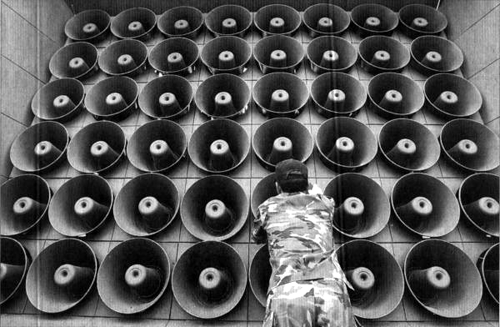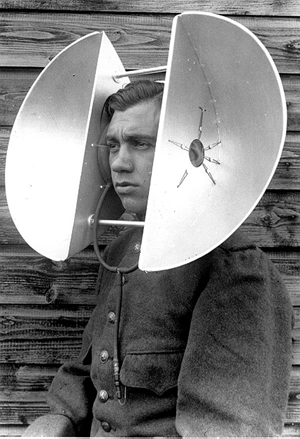1
SETTING UP YOUR HOME STUDIO.

This is giant system of loudspeakers was used during the Korea War in the 1950's to blast propaganda across the Demilitarized Zone that now is the border between South and North Korea.
Image Courtesy Of The Douglas Self Site. |
There are several careful considerations when setting up your own home studio. First of all, where? That spare bedroom will do fine if it is separate enough from the rest of your living area. Home studios tend towards the unsightly, so if your roommate or spouse have tidiness or sound level issues, make sure you can shut the door and cut off the studio from the rest of the household as much as possible.
In addition to making a lot of noise, with a home studio you'll have an increase in people traffic coming and going (musicians etc.). Available extra parking spaces and a back entrance to your studio are good features. If you live in a common-wall apartment or condo, you can avoid a lot problems if you use headphones most of the time...especially if you like to play your music loud. Your recording space will be both the control room and the recording room at the same time...in fact this is advisable if you are a one-person operation where you will be playing, singing, recording and mixing during the course of a session.
You should put all your equipment, that's the mixer, tape deck and/or computer gear, within arms' length reach on a large, stout table in about the center of the room. You'll need access to the back of the equipment almost as much as the front when plugging in cables and making future equipment changes and additions. Furthermore, all the cables will run behind the table and not underfoot. Try to stay away from stacking delicate recording gear on the floor because you have run out of table space. Like any other workspace, organization and everything in its place also works in your home studio.
2
CHOOSING THE RIGHT GEAR.
Many people setting up home demo studios for the first time buy all the wrong gear. Even after consultations with seasoned pros (who recommend their favorite stuff), pro-audio salesman (who steer people toward gear they make more profit on) or other songwriters (who favor their own rigs), I hear a lot of complaints about being dissatisfied with their setup choices. The best way to select all your equipment is to use it before you buy it. Many stores have in-store studio setups or return policies for major expenditures so take a long serious look and ask a lot of questions.
Nowadays, there are two paths to follow: tape based recording or hard-disk computerized recording. Both methods have their advantages and disadvantages. Tape-based is simpler and the cheap tapes are interchangeable with other studios. But tape is subject to breakage, limited in the number of recording tracks and recording time per tape and editing is difficult. Hard-disk recording is faster, more expensive (although getting cheaper) has more editing possibilities but relies on a fast and well working computer with a properly maintained hard-drive. If your computer crashes, you can lose everything you've recorded unless you buy a back-up system and copy your hard-drive data often.
If you use MIDI sequencing to make music, you are already comfortable with the computer so hard-disk would be a natural progression for you. If you just wanna rock with your buddies and are not interested looking at computer screens or dealing with hard-drive maintenance, go with a tape recorder-based system. Since hard-disk recording is becoming so popular, the resale price of all tape-based gear like recording decks, synchronizers and mixers is dropping fast...a consideration if you are trying to save money.
3
CAPTURING THE SOUNDS YOU HEAR IN YOUR HEAD.

A Primitive Personal Listening Rig Used in WW I
Image Courtesy Of The Douglas Self Site. |
Realizing a sound you have in your head is not an easy process even for seasoned pros. One thing is for sure, everyone even pros, work very hard to get what they want. Unfortunately for the beginner, this process can be a frustrating learning experience made easier if you have a game plan.
Try this: compare your sound idea with a similar sound you heard on a CD. If you are working on a simple bass sound, carefully listen to the bass sound on the CD you like and break it down. Here are some questions (in order of importance) that will help you. This process is intuitive and automatic for professionals but might be new to you.
Instrument choice: What instrument or synth patch is playing the bass part?
Same as mine or not?
Range: In what octave is the bass playing? Same as my bass?
Stylistically: What style do you want? Styles and specific musical genres dictate note choices, playing techniques and sound quality.
Musically: Is your bass part the same sort of style as the CD's?
How different? More busy? More legato? More percussive?
More or less expressive...soloistic? Simpler and more basic?
Harmonically similar playing? More root and fifth? More melodic?
Feel: Do you want your bass part more supportive of the chord changes or the melody or both? Does the bass push the track in an aggressive way? How does your bass part feel to you in the context of your song?
Sound quality: Clear, no distortion? Played through a guitar amp?
Dynamic, i.e. lots changes in volume or less dynamic via a compressor.
Anyway, you get the idea and all of this might seem overly analytical but it is good to develop a vocabulary with which to discuss your musical ideas and sound ideas with engineers, musicians, singers and co-writers. Your mental pictures of your song recording can be qualified into a "shape" of the overall sound and "vibe". Once you have this shape in clear view, then you will "deconstruct" and define the individual components that contribute or subtract from realizing that Sound In Your Head.
4
THE RECORDING PROCESS.
Recording is, for the most part, a linear process: you start at the beginning and make your way down the tune. This stabilizing idea of linearity liberates your mind to concentrate on musical performance and emotion....definitely non-linear thinking. So like good song structure and arrangement, you have a good starting foundation to zero in on what needs to happen to make the whole recording better...be it musical arrangement and ideas, vocalizations or just fixing mistakes.
If you are doing a simple song demo and recording the track first, then the qualities of the track and the performance of the musicians are the main focus to the exclusion of all others. After the track is complete, recording vocals becomes the main focus. Simplistic as this sounds, I have had many professional people obsessing about track problems while the singer is out on the mic well after the track was signed off by everyone in the production team!
It is obvious that you have to concentrate on exactly what is going on in your session at that moment and you must setup you studio environment and vibe to cater to that process. I like to be completely prepared to make a good quality recording from the very first take. A lot of musicians and singers give performances on the first take that cannot be duplicated any other way again. Knowing how you equipment works intimately is worth more than having the most expensive or newest gear. There are many books covering recording engineering if you are a novice but it is worth paying an engineer for your important recordings and trying to learn by watching.
5
MIXING.
Mixing is the final step in the process of recording. In the mix, all the elements of your song are assessed and blended in proper balance. It is time to mix when you are satisfied (within time and budget constraints) that all the elements: track, vocals, solos are as best as they can be. If you can make a featured part of the song better through re-recording or computer editing, do it before you mix. Trying to mask weaknesses in the track with lots of reverb or distortion fools nobody. Mixing is another good time to call an engineer if you feel overwhelmed. An outside ear, free of the good and bad memories of the recording process, will give you a fresh and realistic perspective of your song and production.
If you're mixing a song demo, the main thing as they say is "selling the song". You'll need to mix the vocal upfront with as clear and good sound as possible. Listeners, who are interested in your song and songwriting craft, want to hear the words and melody distinctly. Once again, listening carefully to CD's you like will reveal how producers and engineers carefully structure the "size" of a record's individual instruments, vocals and solos to create a mood and overall sonic picture.
Many song demos also serve to represent both the vocalist and the production team. If you are trying to impress A&R personnel with your production, emphasizing the track over the vocal and lyric import will not work. It will be recognized as a bad mix. A good mix that fits the song and its genre represents your production savvy best.
| |